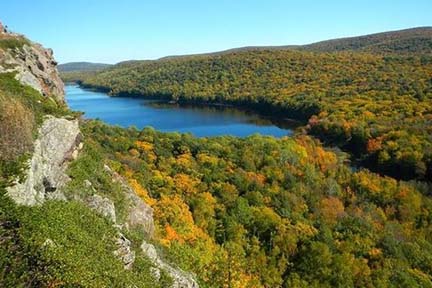
MHSAA NOW: The weekly newsletter
THIS WEEK
Today’s edition includes the report from the MHSAA Representative Council Spring Meeting including notable changes approved for 2022-23. We also feature the McBain Northern Michigan Christian girls soccer and Marysville softball teams, and recall a legend in girls tennis as part of our “Title IX at 50” celebration. We take another look back into history at some of the 25 Michigan high schoolers who went on to become Major League Baseball first-round draft picks. Henry Ford Health System also fills us in on the benefits of a morning walk on overall fitness.
Do you know a high school sports fan who would enjoy this weekly newsletter? Share this link to register on MHSAA.com and be added to the MHSAA NOW mailing list.
AROUND THE STATE
 Rep Council Approves New Hockey Classification Procedure, Wrestling Weights at Spring MeetingThe selection of a restructured classification procedure for ice hockey and the approval of new boys wrestling weight classes were among the most notable actions taken by the Representative Council of the Michigan High School Athletic Association during its annual Spring Meeting, May 1-2 in Gaylord. |
 Muskegon Oakridge Surging Again, but with Switch to Heavy-Hitting StyleDon’t expect much “small ball” from the Muskegon Oakridge softball team. While veteran Oakridge coach Joe Coletta has fielded speedy teams in the past that terrorized opponents with stolen bases and bunting, this year’s edition manufactures runs the old-fashioned way – by swinging for the fences. |
 Over MLB Draft’s History, Michigan High Schools Graduate 25 1st-Round PicksLong before today’s travel ball captivated the scene, recreation sandlot baseball programs – often sponsored by local businesses and guided by volunteer coaches – sparked the dreams of countless kids, instilling a love of the game and a hope they might, one day, grace a bubble-gum card. |
 McBain NMC Continues Rise as Coach VanNoord’s Leadership Takes RootCOVID-19 prevented Jen VanNoord from receiving a proper soccer sendoff as her time guiding Cadillac’s girls program came to a close. Her McBain Northern Michigan Christian soccer players certainly have given her a proper welcome. And, Northern Michigan Soccer League opponents should be cautioned, if they haven’t been already. |
 Baker-to-Watters Sets Record Book Pace for Lansing Catholic FootballLansing Catholic finished the 2021 football season as 11-player Division 6 champion at Ford Field, and the Cougars offense was paced the last two seasons by a standout quarterback and receiver who both made the MHSAA record book for single-season and career accomplishments. Joey Baker was added for 2,536 yards passing this past season, with 162 completions on 294 attempts and 28 touchdowns through the air. He made the career passing lists with 4,153 yards over 13 games. |
 Title IX at 50: Prychitko ‘Legend In Her Own Time,’ Legend for All TimeWhen Stephanie Prychitko was inducted into the Michigan High School Tennis Coaches Association Hall of Fame in 1987, she was referred to as “a legend in her own time.” What she accomplished remains legendary, and in some ways unequaled in Lower Peninsula girls tennis. |
 Wake Up And Walk! 7 Benefits Of Taking A Morning StrollStill having difficulty fitting exercise into your day? Start by heading out for a morning walk. No matter your fitness level, walking offers tremendous benefits, including improving your mood, managing your weight, increasing your energy and reducing your risk for disease. All you need is a good pair of walking shoes and a place to stroll. |
GAME TIME
Upcoming MHSAA Tournament Schedule
Girls Golfs (UP) · Finals: June 1-4
Boys Tennis (UP) · Finals: June 1-4
Girls Tennis (LP) · Finals: June 2-4
Boys Track & Field · Finals: June 4
Girls Track & Field · Finals: June 4
Boys Golf (LP) · Finals: June 10-11
Boys Lacrosse · Finals: June 11
Girls Lacrosse · Finals: June 11
Girls Soccer · Finals: June 17-18
Baseball · Finals: June 18
Softball · Finals: June 18
MHSAA TV
For a complete list of all games and streaming options go to mhsaa.tv.
MHSAA Podcasts
This Week In High School Sports
Michigan High School Athletic Association Newsletter
1661 Ramblewood Drive, East Lansing, MI 48823
If you would like to unsubscribe from this newsletter, click here.











 Across Michigan, the DNR partners with businesses and outside organizations to enrich visitor experiences at state parks. Concessions contracts cover numerous features, including park stores; kayak, bike and other rentals; food and water parks.
Across Michigan, the DNR partners with businesses and outside organizations to enrich visitor experiences at state parks. Concessions contracts cover numerous features, including park stores; kayak, bike and other rentals; food and water parks.
 Doug Rich, DNR western U.P. Parks and Recreation Division district supervisor, said the relationship with the college has been beneficial, acknowledging the college’s contributions to stabilizing operations at the ski hill.
Doug Rich, DNR western U.P. Parks and Recreation Division district supervisor, said the relationship with the college has been beneficial, acknowledging the college’s contributions to stabilizing operations at the ski hill.
 The DNR began a second bidding process in alignment with Michigan law and the DNR’s commercial use policy.
The DNR began a second bidding process in alignment with Michigan law and the DNR’s commercial use policy.
 At a minimum, the prospective contractors were also expected to provide firewood sales and sea kayak and bicycle rentals.
At a minimum, the prospective contractors were also expected to provide firewood sales and sea kayak and bicycle rentals.




